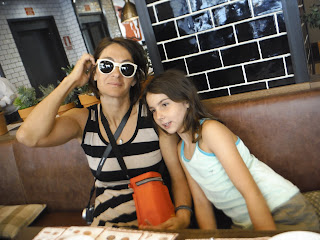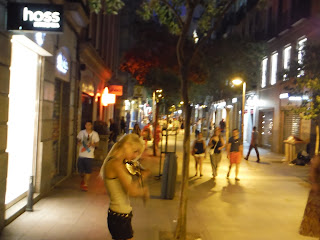The first thing one feels in Madrid is the pulsing presence
of life, art, people, eros, markets, fashion, bodies, and exchanges public space. This is a
city where people cycle, talk, hang out; violinists perform; people talk all night; and sex workers find
business amidst all the goings on - in plazas and the streets. The whole city feels like it thrives in public space.
 |
A few days before our trip, Mom, an art historian, took us
to see some pre-Columbian art at the Princeton art museum.
We surveyed the Mayan works, as well as some of the
contemporary collection.
 |
| Mom showing us some of her favorites in Princeton. she's with us as we walk and think of all she teaches us every day. |
There was so much life in the Americas before the colonizers
made their appearance five centuries ago. The Mayans are
still here and there, living in the forests, their bodies and majestic spirit
everywhere, as is the legacy of colonialism.
Last month, we visited a small town in Mexico, Villadolid, between Cancun and Merida, named after a city in Spain in Castile and Leon. In Mexico, the Spanish literally tore
down the Mayan pyramid there, using the stones to erect a Catholic church and
square in its place. The horrors of colonialism are unending.
Many of the riches of Spain were born from the plundered resources
of the Americas.
This history is still very much with us.
But so is modern Spain and its own treasures.
Mom drove us to the airport advising us about what to
consider from the permanent collection of the Prado, where we would certainly
go our first or second day.
“Go see Van Der Wayden’s La Descente do Croix,” she noted
giving me a list of masters, including Fra Angelico “L’Annunciation., the Meninas,
the Titians, the Reubens.”
If we had a chance, we’d go to Toledo to see the landscapes
that inspired El Greco.
But first we’d have to get to Madrid. Last summer, we left the Camino de Santiago,
to zip down for a few days, before our home stay in Barcelona. Between the art and the vibrant streets, the
art of the galleries and the Moroccan vibe of the Lavapies, we fell in love with the city.
Arriving in Madrid, everyone was jet lagged. Sometimes, waking in the middle of the night
works. But, bouncing back and starting
the day in the equivalent of three in the morning, this is never easy,
especially if we never really got to sleep in the first place.
Our hostel was just off the Gran Via and Calle Montera. People were everywhere. A sex shop down the street and a topas joint,
Tapa Topa, was next door. It would
become our home away from home.
“This is the best meal I have had since I’ve been coming to
Spain,” noted Caroline when she finally got up from siesta.
After lunch, we made our way through the majestic city,
where the temperatures were over 100 degrees.
We caught a tour bus to chill out and beat the heat, while
seeing the city, jumping off at Piramides for a stroll across the Puente de Toledo, where we lulled in the grass along
the waterfront, chilling out.
We’d stay out late that night, enjoying a late meal of pasta
out in a square. The sun did not go down
until 10 pm, the streets getting more and more full and it descended and people
made their way out after their siestas.
Some make their way out at 8 or 10 depending.
After just enough sleep, we woke to visit Tapa Topa again.
I waited 44 years of my life to see the master works of the
grand collection of the Prado, focusing on Italian, German and American art for so many
years of my life. But in college, I
started reading more and more of the magic realist authors, starting to see the
debt they owed to Spain and its lingering literary, economic, cultural and artistic
legacy. This is the land of Cervantes after all. When we say all power to the imagination, we
are reminded of the master adventurer. To be a good explorer, one need not let truth impede on things to much. And conversely, Marquez reminded the world
not to impose its reality or point of view on the land it once colonized. There are multiple realities. This is legacy of Cervantes and Velasquez,
who asked us to inquire about the nature of the observer and painter, the
subject and artist, the mirror and reflection, wondering who was painting or
creating whom in the Meninas. The
collection of the Prado is exquisite. Its not without its limitations as a
testimony of the art of a colonial power, Christian subject matter, and mostly
male painters. But for what it is, it is
extraordinary. I was glad to go
again.
The last time we went, Caroline and I were moved with Goya,
Tintoret, Barbieri, Caravaggio, and Reubens.
His odd Rape of Ganymede struck a chord.
For its exposition of male rape and raw sexuality, the work
is extraordinary and unique. With a
museum full of female nudes, the subject of male rape is rare, almost
unheard of.
 |
| caravaggio |
I was moved by so many of the works. The Jorge Ribera La Songe de Jacob, the
Caravaggio’ David and Golliath, the Atelier Romain Oreste and Pylade, the Goyas, and Breughal touched
me. In their own way, eachn of their works here invite us into emotional subjectivities, vistas of hope and joy, terror and loss, eros and death.
The Menines once again invited observers to wonder about the space
between self and the artist, reminding us to that we keep these works alive when we
observe them, just like we keep authors alive when we read their works. Standing in front of the master, I wondered what
he hoped for us to take away from this portrait as we observed the reflected
image of the artist observing both us and the backs of his subject, or was it
reflection or us in the Prado centuries later?
As we wondered through Caroline was more and more overwhelmed
with the Christian subject matter, which she felt was
oppressive. If you are not Christian,
what is this material saying to you, she wondered.
But within the subject matter, we can engage questions about
subjectivities as the Van Der Wayden’s La Descente do Croix demonstrates,
inviting us to contemplate the image and feeling of both dead and sleeping
subjects.
We wondered all day afterward. The pulse of the city is perhaps the most dynamic work of art in this city of cross currents, ideas, and landscapes.
The gals had chiroz and chocolate, juevos and café con leche
the next day and we were off to Logrono to begin what we started with the
Camino de Santiago, but not without a few days in Mad Madrid.







































































































No comments:
Post a Comment